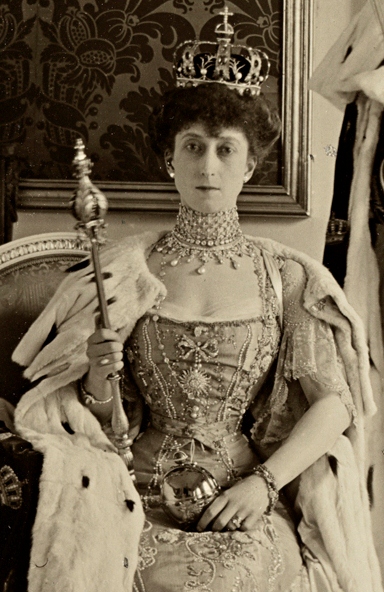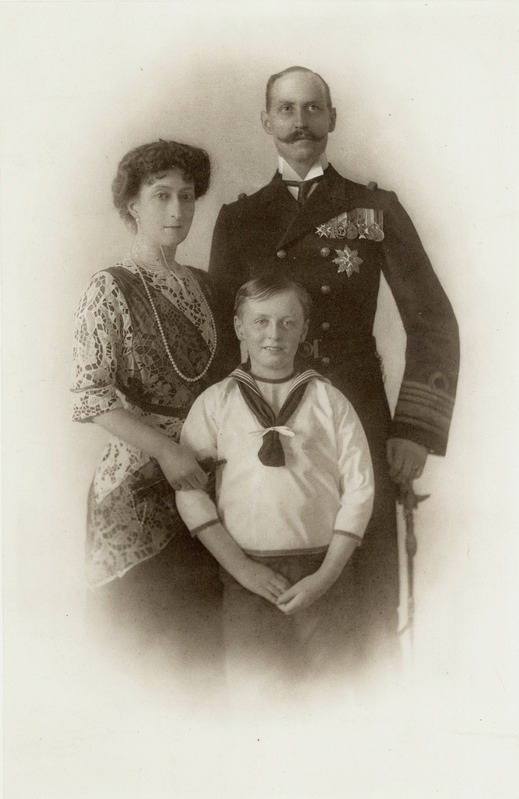by Susan Flantzer © Unofficial Royalty 2014

Maud of Wales, Queen of Norway; Credit – Wikipedia
Queen Maud of Norway was born Princess Maud of Wales on November 26, 1869, at Marlborough House in London, England. She was the third and youngest daughter and the fifth of the six children of King Edward VII of the United Kingdom and Alexandra of Denmark.
The infant princess was christened Maud Charlotte Mary Victoria at Marlborough House, her parents’ London home, on December 24, 1869. Her godparents were:
- Prince Leopold (her paternal uncle)
- Prince Friedrich Wilhelm of Hesse-Kassel (her maternal first cousin once removed)
- Count Gleichen (her paternal half-first cousin once removed, born Prince Victor of Hohenlohe-Langenburg)
- Duchess of Nassau (born Adelheid-Marie of Anhalt-Dessau, wife of the future Adolphe, Grand Duke of Luxembourg)
- King Carl XV of Sweden
- Marie, Princess of Leiningen (wife of her paternal half-first cousin once removed, born Marie of Baden)
- Maria Feodrovna, Tsarevna of Russia (her maternal aunt, born Princess Dagmar of Denmark)
- Crown Princess Louise of Denmark (her maternal aunt by marriage, wife of the future King Frederik VIII of Denmark)
- Duchess of Inverness (her great-great-aunt by marriage, born Cecilia Underwood, morganatic wife of Prince Augustus, Duke of Sussex, uncle of Queen Victoria)
Princess Maud had five siblings:
- Prince Albert Victor (Eddy), Duke of Clarence and Avondale (1864 – 1892), engaged to Princess Mary of Teck, died of pneumonia at the age of 28
- King George V (1865 – 1936), married Princess Mary of Teck; had issue
- Princess Louise, Princess Royal (1867 – 1931), married Alexander Duff, 1st Duke of Fife; had issue
- Princess Victoria (1868 – 1935); unmarried
- Prince Alexander John (April 6, 1871 – April 7, 1871)
Growing up, Maud was the most exuberant of the three sisters and was known as Harry in the family. She developed a one-sided romance with Prince Francis of Teck, the brother of her future sister-in-law Mary of Teck. Maud and Francis exchanged a couple of letters, but it was soon apparent that Francis was not interested in Maud.
Because Maud’s mother was a Danish princess, Maud visited her Danish relatives often and was familiar with her first cousin Prince Carl of Denmark (later King Haakon VII of Norway), the second son of King Frederik VIII of Denmark, who was three years younger than Maud. On October 29, 1895, the couple’s engagement was announced. The Prince of Wales (future King Edward VII) gave his daughter Appleton House on the Sandringham Estate for Maud to use on her visits to England.
Maud and Carl were married in the Private Chapel at Buckingham Palace on July 22, 1896. The bride wore a dress of white satin with a belt of silver embroidery and a wedding veil of old lace, a present from her grandmother Queen Victoria. The couple spent their honeymoon at Appleton House. Maud was so reluctant to leave England, that the couple was still at Appleton House five months after the wedding.

Painting by Laurits Tuxen; Credit – Wikipedia
Maud and Carl finally left for Denmark in December 1896 and took up residence at Bernstorff Palace in Gentofte near Copenhagen, Denmark. Because Maud found the cold Danish winters so difficult to bear, she visited England as often as possible. Maud and Carl had one child, a son:
- Prince Alexander of Denmark, later King Olav V of Norway (1903 – 1991), married Princess Märtha of Sweden, had three children including King Harald V of Norway.

Maud with her husband and son; Credit – Wikipedia
In 1905, upon the dissolution of the union between Sweden and Norway, the Norwegian government began searching for candidates to become King of Norway. Because of his descent from prior Norwegian monarchs, as well as his wife’s British connections, Carl was the overwhelming favorite. Before accepting, Carl insisted that the voices of the Norwegian people be heard regarding retaining a monarchy. Following a referendum with a 79% majority in favor, Prince Carl was formally offered and accepted the throne. He sailed for Norway, arriving on November 25, 1905, and took the oath as King two days later. Carl took the name Haakon VII and his son two-year-old son was renamed Olav and became Crown Prince of Norway. Maud and Carl were crowned in Nidaros Cathedral in Trondheim, Norway on June 22, 1906.

Maud and Carl on the coronation day; Credit – Wikipedia
Recognizing the people’s need to feel that their royal family was Norwegian, Maud and Haakon were photographed in Norwegian folk costumes and enjoying winter sports such as skiing. They ensured their son was raised as a Norwegian, although Maud never became fluent in Norwegian. Maud never gave up her love for her native country and visited often, usually staying at Appleton House. However, she fulfilled her duties as Queen of Norway. Maud became active in women’s rights and the welfare of unmarried women. During World War I, she founded Dronningens Hjelpekomité (the Queen’s Relief Committee) to assist people in difficult circumstances due to the war. Maud was renowned for using clothes and jewelry to give a regal appearance, perhaps something she had learned from her mother.

Maud skiing; Credit – Wikipedia
Maud’s last public appearance in the United Kingdom was in 1937 at the coronation of her nephew King George VI. She rode with her sister-in-law Queen Mary in the glass coach and sat with her in Westminster Abbey. In October 1938, Maud came to England, staying at Appleton House and then at a London hotel. While at the hotel, Maud became ill and was taken to a nursing home where abdominal surgery was performed. She survived the surgery, but died on November 20, 1938, six days before her 69th birthday, from heart failure. Her remains were taken to the chapel at Marlborough House in London, where she had been born and christened. Her casket was then taken by gun carriage to Victoria Station to travel by railroad to Portsmouth and then to travel by sea to Oslo, Norway. Upon arrival in Oslo, the casket was taken to a small church before burial in the royal mausoleum at Akershus Fortress in Oslo. Maud was the last surviving child of King Edward VII and Queen Alexandra. Her husband King Haakon VII survived her for 19 years. He died on September 21, 1957, at the age of 85, and was buried with Maud in the white sarcophagus in the Royal Mausoleum at Akershus Fortress.

White tomb of King Haakon VII and Queen Maud on the left and green tomb of their son King Olav V and his wife Princess Märtha of Sweden, Crown Princess of Norway on the right; Photo Credit – Susan Flantzer
This article is the intellectual property of Unofficial Royalty and is NOT TO BE COPIED, EDITED, OR POSTED IN ANY FORM ON ANOTHER WEBSITE under any circumstances. It is permissible to use a link that directs to Unofficial Royalty.
Kingdom of Norway Resources at Unofficial Royalty
- Kingdom of Norway Index
- Norwegian Monarchs
- Norwegian Orders and Honours
- Norwegian Royal Burial Sites
- Norwegian Royal Christenings
- Norwegian Royal Dates
- Norwegian Royal FAQs
- Norwegian Royal Residences
- Norwegian Royal Trivia
- Norwegian Royal Weddings
- Line of Succession to the Throne of Norway
- Profiles of the Norwegian Royal Family
